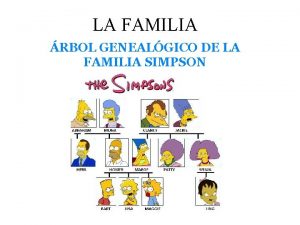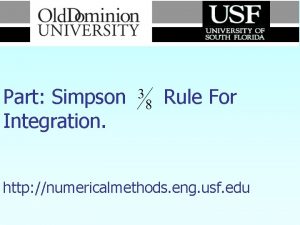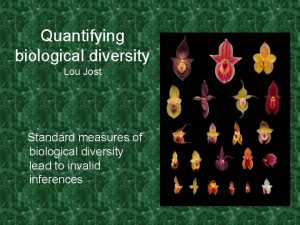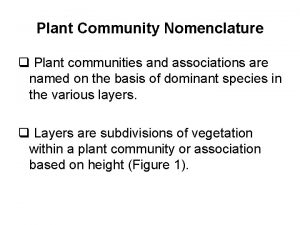Plant Nomenclature Michael G Simpson What is Nomenclature












![What are the ranks? Kingdom Phylum [Division] Subphylum [Subdivision] Class Subclass Superorder Order Suborder What are the ranks? Kingdom Phylum [Division] Subphylum [Subdivision] Class Subclass Superorder Order Suborder](https://slidetodoc.com/presentation_image/3bfa11b2b052304582a02d416f22df05/image-13.jpg)

































![Malacothrix incana (Nutt. ) Torrey & A. Gray [Malacomeris incanus Nutt. ] (=basionym, homotypic Malacothrix incana (Nutt. ) Torrey & A. Gray [Malacomeris incanus Nutt. ] (=basionym, homotypic](https://slidetodoc.com/presentation_image/3bfa11b2b052304582a02d416f22df05/image-47.jpg)







- Slides: 54

Plant Nomenclature Michael G. Simpson What is Nomenclature? Assignment of plant names utilizing a formal system. What is the name of the work providing the rules and recommendations for plant nomenclature? International Code of Nomenclature for algae, fungi, and plants (ICN) (formerly International Code of Botanical Nomenclature, ICBN) What organisms are covered by the ICN? Land plants, "algae, " and fungi (+slime molds, water molds)

What are two basic activities governed by the ICN? 1) Naming new taxa 2) Determining the correct name for previously named taxa (altered in some way)

What are legitimate and illegitimate names? Legitimate Names in accordance with the rules of the ICN Illegitimate Names violate one or more rules of the ICN

How are changes to the ICN made? International Botanical Congress Last held in Melbourne, Australia - July 2011. Next: Shenzhen, China, 23– 29 July 2017.

What are the Principles of Plant Nomenclature? 1) Botanical nomenclature is independent of Zoological and Bacteriological nomenclature. 2) The application of botanical names is determined by means of nomenclatural types. 3) Botanical nomenclature is based upon priority of publication.

What are the Principles of Plant Nomenclature? 4) Each taxon of a particular circumscription, position, and rank can have only one correct name, the earliest in accordance with the rules. [=Fundamental Principle!] 5) Scientific names are treated as Latin. 6) The rules and regulations of the International Code of Botanical Nomenclature are retroactive.

What are the rules vs. regulations of the ICN? Rules = required Recommendations = not required

What is a scientific name? = the names assigned by the rules of the ICN In Latin language E. g. , Malpighia, Alliaceae, Zingiberales

Who first consistently used binomials? Linnaeus What is the correct form of binomials? Binomial = “two names” E. g. , for Quercus dumosa Nuttall Quercus = genus name (capitalized) dumosa = specific epithet (not capitalized) Quercus dumosa = species name Nuttall = author

Scientific Names usually italicized or underlined: Quercus dumosa Nuttall Scientific Names may be bolded: Quercus dumosa Nuttall

Name the reasons that common names are disadvantageous? 1) Only scientific names are universal, used the same worldwide; e. g. , Ipomoea -Woodbine, Morning Glory 2) Common names are not consistent. a) A taxon may have more than one common name (e. g. , chamise, greasewood for Adenostoma fasciculatum). b) One common name may refer to more than one taxon (e. g. , ”hemlock” for both Tsuga and for Conium maculatum). 3) Common names tell nothing about rank; scientific names do. 4) Many, if not most, organisms have no common name in any language.

What is rank? Hierarchical classification in which a higher rank is inclusive of all lower ranks. What is position? Placement as a member of a taxon of the next higher rank E. g. , Aster & Rosa of same rank (genus) but different positions (Asteraceae & Rosaceae)
![What are the ranks Kingdom Phylum Division Subphylum Subdivision Class Subclass Superorder Order Suborder What are the ranks? Kingdom Phylum [Division] Subphylum [Subdivision] Class Subclass Superorder Order Suborder](https://slidetodoc.com/presentation_image/3bfa11b2b052304582a02d416f22df05/image-13.jpg)
What are the ranks? Kingdom Phylum [Division] Subphylum [Subdivision] Class Subclass Superorder Order Suborder Family Subfamily Tribe Subtribe Genus Subgenus Section Species Subspecies Variety (various) Plantae -phyta Magnoliophyta -phytina Magnoliophytina -opsida Magnoliopsida -idae Asteridae -anae, [-iflorae] Asteranae -ales Asterales -ineae Asterineae -aceae Asteraceae -oideae Asteroideae -eae Heliantheae -inae Helianthinae (various) Helianthus annuus (various) Helianthus annuus ssp. annuus (various) Helianthus annuus var. annuus

Major Rank Endings: Order Family Subfamily Tribe Subtribe Genus Subgenus Section Species Subspecies Variety -ales -aceae -oideae -inae (various) (various) Asterales Asteraceae Asteroideae Helianthinae Helianthus annuus Helianthus annuus ssp. annuus Helianthus annuus var. annuus

What is the rank of: Zygophyllaceae family Tribonanthes genus Rosales order Linnaea borealis var. longiflora variety Tribonanthes variegata species Phlebocarya ciliata subsp. pilosissima subspecies Conostylidoideae subfamily Haemodoreae tribe Hamamelidae subclass Liliopsida class Magnoliophyta phylum

Alternate Family/Subfamily Names Apiaceae = Umbelliferae Arecaceae = Palmae Asteraceae = Compositae Brassicaceae = Cruciferae Clusiaceae = Guttiferae Fabaceae = Leguminosae Lamiaceae = Labiatae Poaceae = Gramineae Faboideae = Papilionoideae

What is a ternary name? subspecies or variety name (both are infraspecific names) E. g. , Toxicodendron radicans subsp. diversilobum (diversilobum = subspecific epithet) Brickellia arguta var. odontolepis (odontolepis = varietal epithet) What is of higher rank?

Authorship? the name of the person who first validly published the name

E. g. , Rosaceae Jussieu Conostylideae Lindley Mohavea A. Gray Mohavea confertiflora (A. DC. ) A. Heller Monardella linoides A. Gray ssp. erecta (Abrams) Elvin & A. C. Sanders AUTHOR NAMES OFTEN ABBREVIATED: Haemodoraceae R. Br. (for Robert Brown) Liquidambar styraciflua L. (for C. Linnaeus) CHECK http: //www. ipni. org (standardized)

How to learn scientific names: 1) Syllabize and accent. 2) Use mnemonic devices. 3) Learn the etymology (meaning). 4) Practice and review: oral and written recitation.

What is a nomenclature type? Herbarium specimen (usu. ) permanently associated with a name. Holotype - primary specimen upon which a name is based, designated at the time of publication. Isotype - duplicate of the holotype, collected at the same time by the same person from the same place. Lectotype - selected from the original material to serve as the type when holotype not available. Neotype - specimen derived from a non-original collection that is selected to serve as the type.

Taxa at which ranks have types? Types exist for all ranks up to family A specimen described by Linnaeus is the type for Borago officinalis L. is the type for the genus Borago L. The genus Borago L. is the type for the family Boraginaceae Jussieu

What is a priority of publication? Name published first is the legitimate one When and with what publication begin? Species Plantarum by Linnaeus in 1753 (with exceptions) Adverse consequences? How to correct? Nomina familiarum conservanda Nomina generica conservanda et rejicienda Nomina species conservanda

Two reasons for name change? 1) Name contrary to the rules (illegitimate). 2) Additional research has changed definition and delimitation of a taxon.

NEW Research: Phylogenetic studies may demonstrate at taxon to be non-monophyletic

E. g. , Lotus s. l. is not monophyletic

Four major ways that names are changed? United Divided Changed in rank Changed in Position

Name changes: Names may be united: E. g. , Krynitzkia and Cryptantha (Boraginaceae) have been united into one genus, Cryptantha

Solution 1: Unite as a monophyletic group: Lotus s. l.

Name changes: Name may be divided: E. g. , Rhus (Anacardiaceae) split into Malosma, Rhus, and Toxicodendron

Solution 2: Split into separate monophyletic groups Acmispon Hosackia Lotus s. s. Type

Name changes: Name may be changed in position: E. g. , Sedum variegata transferred to the genus Dudleya, the new species Dudleya variegata;

Name changes: Name may be changed in rank: E. g. , Larrea divaricata ssp. tridentata changed to rank of species: Larrea tridentata

What is a basionym? The “name bearing” name. The original (possibly now rejected) name, part of which (the epithet) has been used in a new combination. Author(s) in parentheses? Person(s) who named basionym. Retained!

Basionym E. g. , Sedum variegata S. Watson was transferred to the genus Dudleya by Moran, new species name is: Dudleya variegata (S. Watson) Moran [Note: Sedum variegata S. Watson is the basionym] E. g. , Muhlenbergia shepherdii (Vasey) Swallen transferred to Blepharoneuron by P. M. Peterson & Annable, new name: Blepharoneuron shepherdii (Vasey) P. M. Peterson & Annable [Sporobolus shepherdii Vasey, Bull. Torrey Bot. Club 14: 8. 1887] (=basionym)

What is an autonym? Automatically created name for infrafamilial, infrageneric, and infraspecific taxa. Created when taxa are divided. Assigned based on priority of publication. Autonyms have no authors.

Autonyms: E. g. , Lotus stipularis (Benth. ) Greene split by Isely into 2 varieties: Lotus stipularis (Benth. ) Greene var. ottleyi Isely Lotus stipularis (Benth. ) Greene var. stipularis Later, genus Hosackia accepted: Hosackia stipularis Benth. var. ottleyi (Isely) Brouillet Hosackia stipularis Benth. var. stipularis

Autonyms: Family Euphorbiaceae divided into subfamilies: Euphorbioideae (the autonym) must be one of them Genus Ceanothus split into two subgenera: Subgenus Ceanothus Subgenus Cerastes (Subgenus Ceanothus contains type species for the genus. )

What are the main criteria of valid publication? 1) Name must be effectively published = in a journal generally available to botanists As of 1 Jan 2012: Electronic material published online in Portable Document Format (PDF) with an International Standard Serial Number (ISSN) or an International Standard Book Number (ISBN) will constitute effective publication

What are the main criteria of valid publication? 2) Name must be published in the correct form, properly Latinized with the correct rank ending. 3) Name must be published with a Latin description or diagnosis or with a reference to such. [Vernacular description typically included. ] As of 1 Jan 2012: A description or diagnosis may be in either Latin or English.

What are the main criteria of valid publication? 4) Rank must be indicated (e. g. , “sp. nov. , ” “subsp. nov. , ” or “var. nov. ”) 5) Nomenclatural type must be indicated (for genus and below).



What is a synonym? = a rejected name, by a particular author or authors. Synonyms usu. indicated in brackets; e. g. , Malosma laurina (Nutt. ) Abrams [Rhus laurina Nutt. ] Why rejected? 1) because illegitimate. 2) because of taxonomic judgement.

Two types of synonyms: 1) Homotypic (nomenclatural) – based on the same type specimen E. g. , Cryptantha decipiens (M. E. Jones) A. Heller [Krynitzkia decipiens M. E. Jones] 1) Heterotypic (taxonomic) – based on a different type specimen E. g. , Aesculus L. (1753) [Pavia Mill. (1754)] E. g. , Cryptantha mohavensis (Greene) Greene (1887) [Cryptantha fallax Greene (1902)]

What is a correct name? A legitimate (and therefore validly published) name that is accepted by a particular author or authors. Each taxon can have only one correct name. How can a name be legitimate but not correct? There may be 2 (or more) alternative, legitimate names. Only one of these can be correct (in any given work).
![Malacothrix incana Nutt Torrey A Gray Malacomeris incanus Nutt basionym homotypic Malacothrix incana (Nutt. ) Torrey & A. Gray [Malacomeris incanus Nutt. ] (=basionym, homotypic](https://slidetodoc.com/presentation_image/3bfa11b2b052304582a02d416f22df05/image-47.jpg)
Malacothrix incana (Nutt. ) Torrey & A. Gray [Malacomeris incanus Nutt. ] (=basionym, homotypic synonym) Porophyllum gracile Benth. [P. caesium Greene; P. vaseyi Greene] (=heterotypic synonyms) Gilia diegensis (Munz) A. D. & V. E. Grant [Gilia inconspicua (Sm. ) Sweet var. diegensis Munz] (=basionym, homotypic synonym)

What is a homonym? = synonym identical to accepted, correct name. E. g. : Eritrichium hispidum Philippi, 1860 [Eritrichium hispidum Buckley, 1862] E. g. , Piptocalyx Bentham (Trimeniaceae), 1870 [Piptocalyx Torrey, 1874] What is a tautonym? = binomial in which genus and specific epithets are identical in spelling. Tautonyms are not permitted by the ICN! E. g. , Helianthus helianthus would be a tautonym and illegitimate. Ziziphus zizyphus (L. ) H. Karst. (Jujube) is not a tautonym and is permitted.

Abbreviations: "in" = "in the publication of” E. g. , Arabis sparsiflora Nutt. in T. & G. May be abbrev: Arabis sparsiflora Nutt. "ex" = "validly published by. ” E. g. , Microseris elegans Greene ex A. Gray May be abbrev. : Microseris elegans A. Gray.

Abbreviations: s. l. (sensu lato) means “in the broad sense” s. s. or s. str. (sensu stricto) means “in the narrow sense” E. g. , Boraginaceae s. l. includes the families Hydrophyllaceae, Ehretiaceae, Heliotropaceae, Cordiaceae, and others Boraginaceae s. s. does not (those families are separate)

Abbreviations "x" = a hybrid. E. g. , Salvia xpalmeri (A. Gray) Greene = S. apiana x S. clevelandii. "sp. nov. " = species novum E. g. , "Eryngium pendletonense sp. nov. " "cf. " = confer, meaning "compare. ” E. g. , "Calyptridium cf. monandrum” (meaning check this specimens of species for confirmation) aff. (affine) means “related to” E. g. , Cryptantha aff. wigginsii (meaning something different but a close relative to this species)

aff. (affine) means “related to” auct. non (auctorum non) means “not of these authors, ” referring to a “misapplied” name, such that the type specimen of the name does not fall within the circumscription of the taxon being referred to by that name cf. (confer) means “compare to” comb. nov. (combinatio nova) means a new nomenclatural combination emend. (emendatio) means a correction or amendment et is Latin for “and” ex is Latin for “from, ” meaning validly published by gen. nov. (genus novum) means a new genus in is Latin for “in, ” meaning in the publication of ined. (ineditus) means not validly published nom. cons. (nomen conservandum) means a conserved name nom. nov. (nomen novum) means a new name, e. g. , proposed as a substitute for an older name (e. g. , an illegitimate homonym, in which case the older name serves as the type for the new one) nom. nud. (nomen nudum) means published without a description or diagnosis, making the name invalid non is Latin for “not” n. v. (non visus) is Latin for “not seen, ” typically meaning that authors did not see a specimen, such as a type. orth. cons. (orthographia conservanda) means a conserved spelling s. l. (sensu lato) means “in the broad sense” s. s. or s. str. (sensu stricto) means “in the narrow sense” sp. nov. (species nova) means a new species stat. nov. (status novus) means a change in rank, e. g. , elevating a varietal name to specific status typ. cons. (typus conservandus) means a conserved type specimen typ. des. (typus designatus) means the designation of a type specimen vide (video) means to cite a reference X indicates a hybrid ! (symbol for vidi, “I have seen it”) can mean a) a confirmation of a name, as on an annotation label agreeing with the name on the original herbarium label; or b) indication that a specimen (usually a type) has been seen by the author in a publication = a heterotypic synonym, based on a different type = a homotypic synonym, based on the same type

Independence of Botanical Nomenclature Same names can exist in botanical and zoological codes. Morus = mulberry and a bird, the gannet Morus Ficus = figs and of a group of gastropods. Ficus Both codes can treat same organisms, e. g. , some "Protista". Retroactivity of the ICN

 Simpson index example
Simpson index example Plant introduction in plant breeding
Plant introduction in plant breeding Tronsmo plant pathology and plant diseases download
Tronsmo plant pathology and plant diseases download Intraspecific hybridization
Intraspecific hybridization Tronsmo plant pathology and plant diseases download
Tronsmo plant pathology and plant diseases download Plant introduction in plant breeding
Plant introduction in plant breeding Tronsmo plant pathology and plant diseases download
Tronsmo plant pathology and plant diseases download Trapez kuralı
Trapez kuralı Simpson biodiversity
Simpson biodiversity Homer simpson mri
Homer simpson mri Perro de la familia simpson
Perro de la familia simpson Fda oimt
Fda oimt Regla del trapecio
Regla del trapecio Eunice ann simpson to kill a mockingbird
Eunice ann simpson to kill a mockingbird Nicole simpson autopsy
Nicole simpson autopsy Ling simpson
Ling simpson Euler method truncation error
Euler method truncation error Simpson
Simpson It's not paranoia
It's not paranoia Supa forensics
Supa forensics Kate gilmore
Kate gilmore Indeks kesamaan komunitas
Indeks kesamaan komunitas Where is the focal point in a triangular arrangement?
Where is the focal point in a triangular arrangement? Simpson 3/8 rule
Simpson 3/8 rule Yang termasuk batuan sedimen
Yang termasuk batuan sedimen Simpson biplano
Simpson biplano Dave simpson rbc
Dave simpson rbc Regra dos 13
Regra dos 13 Lister and simpson
Lister and simpson Ainsley simpson
Ainsley simpson Sally simpson umd
Sally simpson umd Formula simpson 3/8
Formula simpson 3/8 Simpson's diversity index formula
Simpson's diversity index formula Lisa simpson slides
Lisa simpson slides Primo de bart simpson
Primo de bart simpson Contoh soal metode trapezoid
Contoh soal metode trapezoid Sod harvesting
Sod harvesting Krusty the clown personality type
Krusty the clown personality type Simpson's 1/3 rule
Simpson's 1/3 rule Skala saffir simpson
Skala saffir simpson Average ordinate rule formula
Average ordinate rule formula Todd simpson hhs
Todd simpson hhs Simpson index
Simpson index O.j simpson case study
O.j simpson case study Rumus simpson 3/8
Rumus simpson 3/8 Simpson psychomotor domain
Simpson psychomotor domain Rist korea
Rist korea Regla del trapecio
Regla del trapecio Numerical integration
Numerical integration Super samson simpson poem
Super samson simpson poem Simpson drives his car with an average velocity of 48
Simpson drives his car with an average velocity of 48 Franklin simpson industrial authority
Franklin simpson industrial authority Bart simpson personality type
Bart simpson personality type How to draw homer simpson
How to draw homer simpson O.j. simpson prosecuting attorneys
O.j. simpson prosecuting attorneys












































































